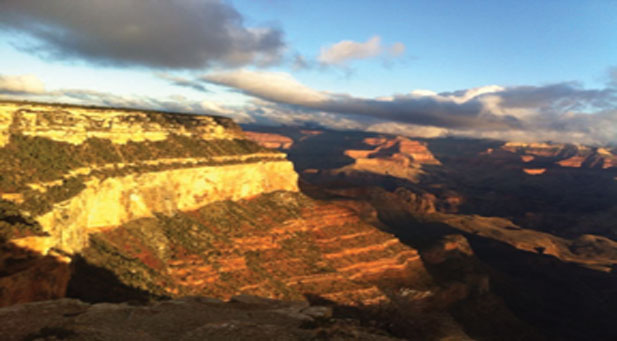
 If you want to see heaven before you die, take a trip to Grand Canyon!
If you want to see heaven before you die, take a trip to Grand Canyon!
By Audrey Peterman
When I was invited to speak at the Grand Canyon in honor of Black History Month and Women’s History Month, my heart overflowed with gratitude. My husband Frank and I have toured 170 of the 401 units comprising the National Park System that extends from Alaska to Florida, and the Grand Canyon National Park is one of my top favorites.
Since I had the opportunity to address members of the public as well as the park’s staff, I chose as my topic “Our National Park System: The Glue That Holds America and the World Together” for the presentation at the Shrine of the Ages. Earlier that day, I’d been introduced to the reigning Miss Teen Navajo, Krischel Augustine, and she eagerly showed up in her full regalia with members of her family.
I started by recognizing the Native Americans as the original conservationists, and mentioned how they had lived more than 10,000 years in the Grand Canyon area while maintaining the integrity of the land. I informed the audience that America was the first country in the world to establish a National Park System “for the benefit and enjoyment of this and future generations.” It protects close to 100 million acres of un-developed land, and more than 100 countries around the world have since established park systems, thus protecting countless millions of acres of the firmament of Earth.
I shared that the National Park System protects the land where pivotal events in our history took place, and that every ethnic and racial group can walk upon and touch the legacy that their ancestors contributed in the development of our country.
Pointing to the Castillo de San Marcos National Monument in St. Augustine, I shared that it was built by the Spaniards in the 1660s to protect the European presence in America. Then I relayed the five-month, 1200-mile journey of Juan Bautista de Anza and the Afro and Native Latinos who trekked with him across deserts, through wilderness and over rivers to reach San Francisco which they settled in 1776. Their route and legacy is protected in the Juan Bautista de Anza National Historic Trail which stretches from Arizona to the Presidio of San Francisco that they helped to build.
To show that Americans of Asian descent were an integral part of the development of the National Park System, I shared how Tie Sing distinguished himself as part of the Mather Mountain Party that explored Sequoia National Park in 1915, to the extent that a 10,000-foot high peak in the park was named Sing Peak in his honor. To illustrate the leadership of women in achieving their God-given rights as fully functioning members of society, I shared the Women’s Rights National Historical Park in New York where the first Women’s Rights Convention was held in 1848 and women such as Elizabeth Cady Stanton, Harriet Tubman and Sojourner Truth changed history.
To highlight the contributions of African Americans, I told the audience that the spot where Crispus Attucks was shot down in the opening salvo of the Boston Massacre of 1770 is protected in Boston National Historical Park; that I have walked the trails in Valley Forge National Historical Park where Black, Hispanic and Native Americans soldiered with George Washington’s Continental Army in the dire winter of 1777-78, and Black women served as nurses and cooks.
I shared the Buffalo Soldiers’ legacy at Fort Davis National Historic Site in Texas, where they protected settlers on the Great Western Migration to California; the Klondike Gold Rush National Historical Park in Alaska, where they kept the peace in the Gold Rush frontier town in 1897.
I also shared that the Buffalo Soldiers protected our most iconic parks, Sequoia and Yosemite in California in the early years of the 20th century, and that a pilgrimage is planned to commemorate their journey from the Presidio to Yosemite National Park June 7 and 8, 2014.
The “Sable Guides,” enslaved Black men, first explored Mammoth Cave National Park in Kentucky from the 1830s; heroine of the Underground Railroad, a Union Spy and nurse in the Civil War Harriet Tubman’s birthplace is included in the Harriet Tubman Underground Railroad National Monument; Frederick Douglass’ home, where the man who was born into enslavement and rose to become a forceful advisor to President Lincoln is protected as part of the Frederick Douglass National Historic Site; Biscayne National Park in South Florida was saved through the efforts of Sir Lancelot Jones, an African American, in the 1970s; and Fort Jefferson in the Dry Tortugas National Park was built by enslaved Africans in the 1830s as part of America’s coastal defense system.
I told the enthralled audience that knowing these stories and walking in the footsteps of my ancestors made me proud to be an American and deeply invested in every occurrence, as I feel that I must honor their legacy by helping achieve a true democracy, with liberty and justice for all. I rounded out the presentation by asking whether people had seen their own ethnicity and gender represented, and received enthusiastic nods in response.
In the four days I spent in the canyon, I reconnected with friends we’ve made in parks around the country; hiked to Shoshone Point at daybreak to catch the dazzling sunrise; had breakfast at the historic El Tovar hotel on the canyon rim; ate a hearty lunch at the Maswik Lodge, and was treated to my first exotic latte at the Bright Angel Bicycle Rentals and Café by an appreciative member of the audience. I am so grateful that we have these special places to reflect, recharge and be rejuvenated in our American heritage!
(Find Audrey Peterman’s book, Our True Nature: Finding a Zest for Life in the National Park System with these stories at www.legacyontheland.com)


Be the first to comment